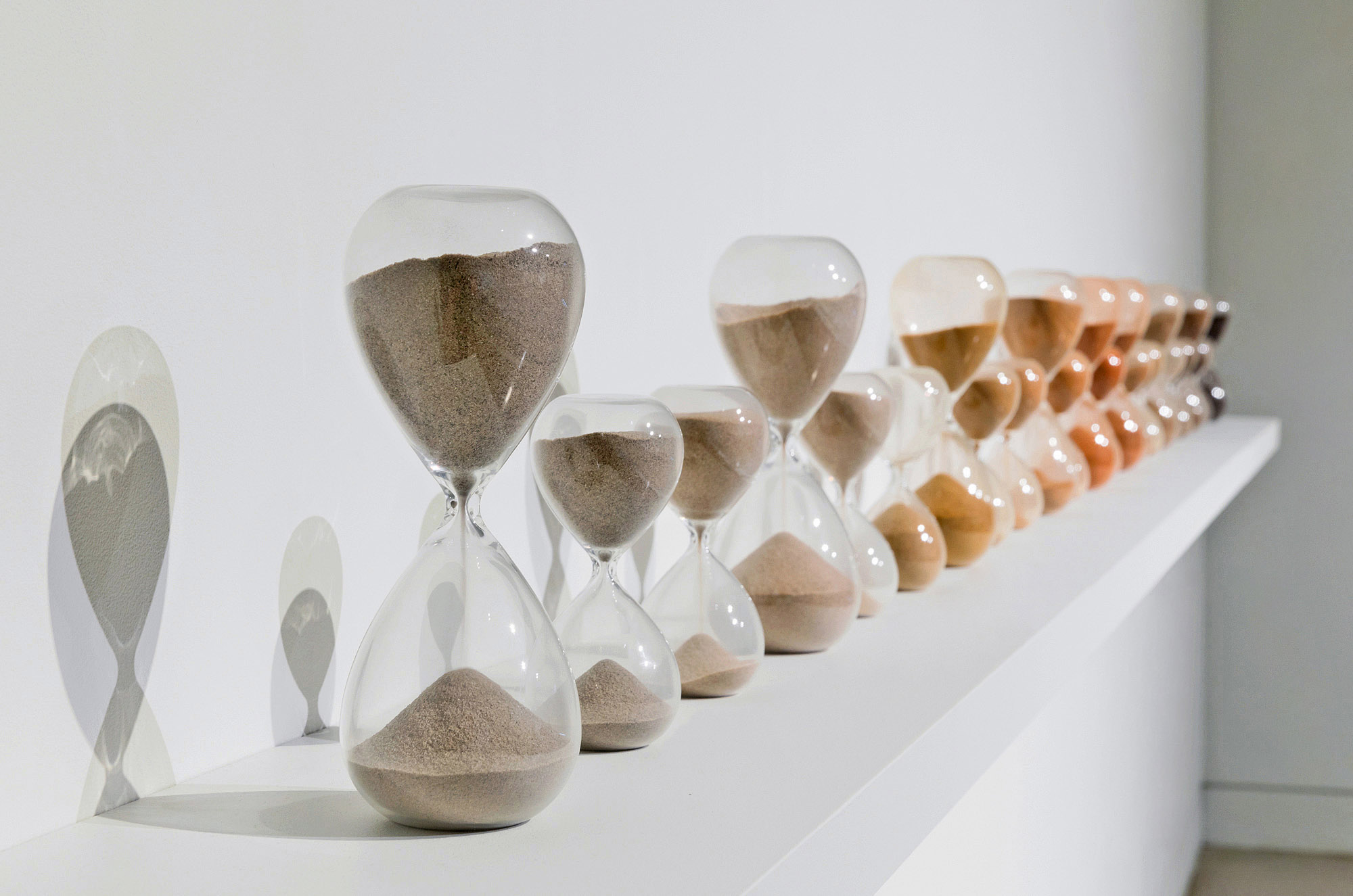VEIL OF TIME
Blue Mountains City Art Gallery, Blue Mountains Cultural Centre, Australia
Permanent collection of the Blue Mountains Cultural Centre, Australia
Part of the solo exhibition Liminal Refugia curated by Sabrina Roesner
Located in Darug and Gundungurra Ngurra (Country)
Supported by the Ontario Arts Council
Hand-blown glass, mineral samples from the Blue Mountains region of Australia
2018
In recognition of the geodiversity and geoheritage values of the Greater Blue Mountains UNESCO World Heritage Area, a constellation of mineral samples gathered by over 65 individuals across the region was ground and finely sieved to create Veil of Time. Unravelling like a geologic time scale, the graduated array of minerals preserved in hand-blown hourglasses evokes the delicate formation of the region’s caves in which rainwater etches quartz grains from absorbent sandstone. This process of cavernous weathering of sandstone cliffs and pagodas slowly releases fine grains of stone as the cave hollow develops, depositing a shoreless beachscape onto the evolving cave floor below.
From December 2017 to February 2018, residents and visitors in the Greater Blue Mountains area were invited to be part of a participatory art project about the geodiversity of the Greater Blue Mountains UNESCO World Heritage Area by gathering a small sample of natural earth from the region. Over 65 community members and visitors in the Greater Blue Mountains region contributed small earth samples thoughtfully gathered earth from around homes, fragrant gardens, bushland, bushwalking pathways, bushfire regeneration areas, and day-to-day places of personal significance. To respect the fragility and intrinsic ecological and cultural values of the World Heritage Area, participants were asked to not gather samples from Aboriginal places or sacred sites, conservation reserves, flora reserves, national parks, state conservation areas, state forests, or other nature reserve areas.
The Earth’s mantle of soil—called the pedosphere—is the thin soil fabric that blankets the ground, comprising natural bodies of mineral and organic compositions, which in the Greater Blue Mountains primarily consist of layers of sandstone, basalt, and shale. Reflecting this mineral composition, most of the earth samples received consisted of sand and clay.
The term “geodiversity” or geological diversity refers to all non-biological elements that shape the Earth: the soils, stones, fossils, geological formations, and landscape-forming processes that are the foundation for all living things, including human life on the grand geologic time scale. Geodiversity is intimately linked with biodiversity and is similarly affected by change. In the Greater Blue Mountains, geodiversity features include magnificent erosional elements such as caves, rock shelters, cliffs, slot canyons, bottleneck valleys, and sandstone pagodas. These ancient forms possess intrinsic values even if they are not the habitat of significant ecosystems.
When considering geodiversity within the context of Australia, it is essential to observe the limitations of this term, as well as English words such as “earth” and “minerals”, which have only existed in the Greater Blue Mountains World Heritage Area for about 200 years. Whereas, six distinct Aboriginal language groups—Darkinjung, Darug, Dharawal, Gundungurra, Wanaruah, and Wiradjuri—have been expressing and caring for Ngurra (Country) in the region for tens of thousands of years. Words that communicate a diversity of complex concepts and intricate knowledge systems related to understandings of earth, minerals, and interconnected natural phenomena in Aboriginal languages were spoken, shared, and lived across this region, and in relation to specific bushland places, thousands of years before English was first spoken in Australia.
Shielded from the elements yet created by them, the sandstone caves of the Greater Blue Mountains are mainly formed in the Narrabeen strata of sedimentary layers that tell the story of more than 200 million years of intricate and enduring geological history of eastern Australia’s Sydney Basin. Found at the bases and cliff edges of globally significant sandstone pagoda formations unique to the Greater Blue Mountains, these commanding geomorphic structures were sculpted over time by the slow movement of water through stone. This process of cavernous weathering etches the quartz grains from the absorbent sandstone body. Like a mythic hourglass, waves of time gradually deposit a soft mineral bed below as the rock hollows—a bone-dry beach harboured beneath the cave’s protective stone arch.
In 2000, the Greater Blue Mountains Area was included in UNESCO’s World Heritage List on the basis of biodiversity but not geodiversity due to insufficient evidence at the time. In Recognising New Values: The Geodiversity and Geoheritage of the Greater Blue Mountains (2015), Haydn Washington and Robert Wray reveal that more recent scientific research by geologists and geomorphologists presents a strong case for the Greater Blue Mountains to be officially recognized for meeting the criteria of outstanding universal values for both biodiversity and geodiversity (1). Veil of Time is a gesture in support of honouring and protecting the enduring existence of these geoheritage values.
Veil of Time was acquired by the Blue Mountains Cultural Centre for the permanent art collection in 2018. In May 2022, the work was exhibited at the gallery a second time as part of the anniversary exhibition Above the Clouds: 10 Years of the Blue Mountains Cultural Centre Collection.
VEIL OF TIME
Studio Detail, Australia, 2018
1. Washington, Haydn and Robert Wray. "Recognising New Values: The Geodiversity and Geoheritage of the Greater Blue Mountains." Chapter 1 in Values for a New Generation: Greater Blue Mountains World Heritage Area. Greater Blue Mountains World Heritage Area Advisory Committee, 2015, p. 14.
Karen Miranda Abel wishes to express respect and acknowledgement to the Elders, individuals, families, and communities of the six Aboriginal language groups—Darkinjung, Darug, Dharawal, Gundungurra, Wanaruah and Wiradjuri—who are the original and continuing carers of country in the Greater Blue Mountains World Heritage Area, Australia.
Special thanks to Bilpin International Ground for Creative Initiatives, Australia
The Blue Mountains Cultural Centre and the Ontario Arts Council are gratefully acknowledged for funding this exhibition







